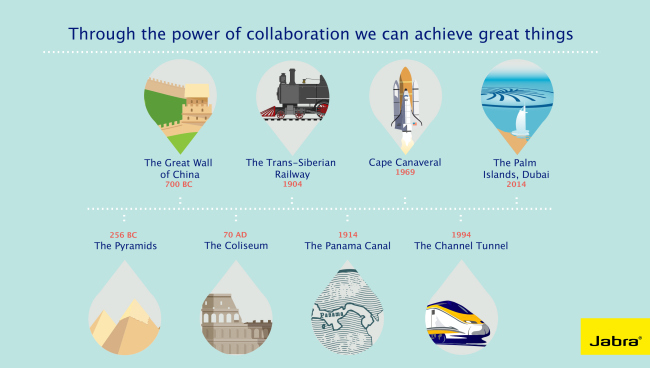Contact Centre Collaboration – from the pyramids to the moon landing – Article by Holger Reisinger of Jabra
Every time you return a call from a co-worker, discuss a project with a colleague or conduct a teleconference, you’re participating in an activity that has been moving civilization forward since the beginning of time. But what is collaboration really—and why is it now more important than ever?
I just watched a fascinating video that got me thinking about how we as people work together to solve problems and improve our world. The video was about some of history’s greatest engineering feats—from the pyramids to the London Underground to the moon landing
As I pondered these accomplishments from the perspective of someone who knows little about engineering but a bit about technologies that enable people to work more closely together, I was even more awed.
What I was seeing was impressive feats of something we as humans practice all the time, often without even realizing it: collaboration.
Of course, collaboration is one of those words that can be defined in any number of ways. From my perspective, collaboration is the act of getting people together within an organization, either physically or virtually or both, to turn problems into solutions.
Vint Cerf, renowned as one of the “fathers of the Internet,” seems to agree. In a recent interview he explained, “Collaboration, in my view, is multiple people working on the same problem and exchanging ideas.”
And when it came to burrowing a tunnel beneath London, there were no shortage of challenges to overcome. The amount of collaboration—as represented by meetings, discussions, and conversations—had to be almost beyond comprehension. With reputations at stake and lives on the line, no detail was too small.
It’s important to note that collaboration represents all the interactions within an organization that enable people to resolve a specific business issue. That separates it from other, slightly different models of interaction we often hear about, such as co-creation and open innovation, in which people work across organizations to accomplish a desired outcome.
Moving Us Forward Now, I’m hardly a philosopher. But the more I thought about collaboration, the more I realized that it is the fuel that has propelled humankind since the dawn of time. It reflects our innate desire to face issues, solve problems and improve the world around us. It harnesses the power of many over that of the mere individual. And it’s what differentiates us from the other creatures that roam the earth—and inspires us to introduce new technologies, achieve medical breakthroughs, improve living conditions in faraway places, the list goes on.
Of course, the way we collaborate is changing at a dizzying pace.
Technology enables us to break down geographical, temporal and cultural barriers as never before. We can share information with anyone, anywhere and in any form—text, voice, video and more—instantly. The scientists and engineers who landed the first man on the moon could only wish they enjoyed the benefit of videoconferencing, instant messaging and email. Yet they pulled off an amazing accomplishment using quintessentially 20th century tools: memos, meetings and, gasp!, rotary telephones. They must have been masters of collaboration.
Are We Collaborating or Just Meeting? Productive collaboration is as necessary and important today as ever. Yet I wonder if our ability to do it effectively has been replaced by the act of “booking yet another meeting.”
The truth is, we can collaborate so much better that we are currently. How? By not just deploying new tools and technologies, but encouraging employees to embrace and use them to their full potential. By finding creative ways to build more productive teamwork. By transforming mindless meetings and e-mail ping-pong into spirited, problem-solving sessions.
But I’m getting ahead of myself. We’ll discuss all these topics and more in future blog postings. The common denominator across all of them, of course, is harnessing the power of collaboration within the organization to solve problems and improve our world. That’s something the engineers, scientists and workers of a previous era perfected and we’d be wise to emulate.
Additional Information
To learn more about new ways of working, read Holger Reisinger’s blog by Clicking Here
For additional information see Jabra’s Company Profile






